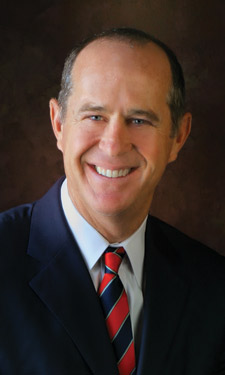
One doesn’t immediately think of Anaheim—known in the U.S. for its tourism industry—as a private place. But for Mayor Tom Tait, strengthening connections among the city’s 343,000 residents is a priority.
“It’s very interesting in southern California. Culturally, people are much more private than I think they are in smaller towns or other parts of the country,” Tait says. “We are particularly challenged… because of the way the houses are laid out—not really having front porches…and people using their automatic garage door openers to go in and out.”
In January 2011, in conjunction with his vision to instill a core value of kindness in Anaheim, Tait announced the launch of “Hi Neighbor,” an outreach campaign focused on safety, community building, and emergency preparedness. The initiative is a revival of a program created in 1959 by the Anaheim Lions Club in response to the city’s growth. Over a period of several years, residents gathered annually for a Hi Neighbor Day festival in Pearson Park or LaPalma Park to meet each other, learn about city services, and enjoy food and entertainment.
By adapting the Hi Neighbor concept to the modern day, Tait believes Anaheim can be better prepared to deal with challenges and unforeseen disasters. Included in the initiative are an online portal and free social media site where residents can acquire resources and exchange information related to things such as event planning, neighborhood watches, and disaster recovery.
“When people come together, good things happen,” Tait says. “[Hi Neighbor] is part of a social infrastructure…to make sure when people are maybe up to no good, neighbors are looking out for one another.”
He continues, “Here in California, we’re one day closer to that big earthquake or some other emergency that could potentially overwhelm our fire departments or police departments. So, it has to be neighbors that come together to help one another.”
When asked where parks fit into the fold, Tait speaks matter-of-factly.
“To get people to connect, we have to have a place where they can connect. That place is our parks.”
To spur connections outdoors, Hi Neighbor recently piloted a six-month initiative to create several community gardens in Anaheim, in conjunction with Anaheim Community Gardens and Council Member Gail Eastman. Tait notes the involvement of more than 5,000 students who helped to grow seedlings in classrooms, and credits the project with rallying residents around a park in an at-risk neighborhood.
The mayor notes the importance of this park and others in connecting residents in a community that—like many in Southern California—deals with its share of crime and gang-related issues. He mentions a situation in Pearson Park as a poignant example.
“A few years ago [the] neighborhood was in trouble…crime was going up, and there was a lot of drug dealing,” Tait says. “The neighbors came together to save the park. They started doing flashlight walks at night, and they took ownership. The park united people in kind of an unexpected way, and through that…tremendous acts of kindness have sprouted.”
It could be said that Tait’s professional experiences make him a likely supporter of parks and recreation. In addition to his role as president of Tait & Associates and Tait Environmental Services, the former city council member and Mayor Pro Tem has a history of involvement with organizations such as the Metropolitan Water District of Southern California and the YMCA. But, as Tait points out, it is personal experiences, specifically multiple visits to soccer fields each week as a coach while his children were growing up, that helped him build strong connections to Anaheim.
Tait’s personal use of Anaheim’s parks has changed over the years—he mainly now enjoys walking through the parks near city hall—however, the impact parks have had on his outlook is evident. “Think about the glue that holds a community together,” he states. “To make it resilient…imagine doing that with no parks. It just doesn’t happen.”
Amy Kapp is a freelance writer in Fairfax, Virginia.

